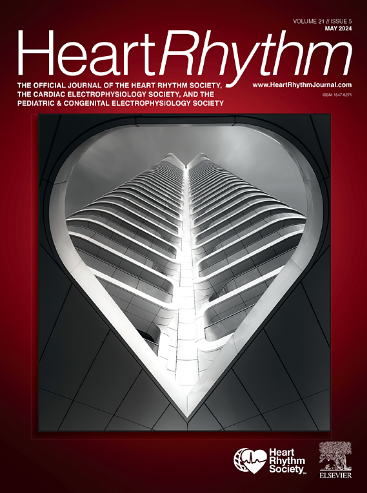The functional substrate in patients with atrial fibrillation is predictive of recurrences after catheter ablation
IF 5.6
2区 医学
Q1 CARDIAC & CARDIOVASCULAR SYSTEMS
引用次数: 0
Abstract
Background
Enhanced characterization of the atrial electrical substrate may lead to better comprehension of atrial fibrillation (AF) pathophysiology.
Objective
With the use of high-density substrate mapping, we sought to investigate the occurrence of functional electrophysiological phenomena in the left atrium and to assess potential association with arrhythmia recurrences after catheter ablation.
Methods
Sixty-three consecutive patients with AF referred for ablation were enrolled. Analysis of conduction abnormalities relied on two acquired left atrial electroanatomic maps (sinus and atrial paced rhythm). We classified conduction abnormalities as fixed (if these were present in both rhythms) or functional rhythm dependent (if unmasked in one of the two rhythms). Esophagus and aorta locations were recorded to check the correspondence with abnormal conduction sites.
Results
There were 234 conduction abnormalities detected, of which 125 (53.4%) were functional rhythm dependent. The most frequent anatomic site of functional phenomena was the anterior wall, followed by the posterior wall, in sinus rhythm and the pulmonary venous antra in paced rhythm. Sites of functional phenomena in 82.6% of cases corresponded with extracardiac structures, such as sinus of Valsalva of ascending aorta anteriorly and the esophagus posteriorly. Most (88%) areas with functional phenomena had normal bipolar voltage. After pulmonary vein ablation, the number of residual functional phenomena is an independent predictor of AF recurrence (hazard ratio, 2.539 [1.458–4.420]; P = .001) with a risk of recurrences at multivariable Cox analysis.
Conclusion
Dual high-density mapping (during sinus and paced rhythms) is able to unmask functional, rhythm-dependent phenomena that are predictive of AF recurrences during follow-up.
心房颤动患者的功能基质可预测导管消融术后的复发情况。
背景:增强心房电基底的特征描述可能有助于更好地理解心房颤动(房颤)的病理生理学:通过使用高密度基底图,我们试图研究左心房功能性电生理现象的发生,并评估与导管消融术后心律失常复发的潜在关联:方法: 63名连续的房颤患者接受了导管消融术。传导异常分析依赖于两次获得的左心房电解剖图(窦性心律和心房起搏节律)。我们将传导异常分为固定异常(如果在两个节律中均存在)和功能性节律依赖异常(如果在两个节律中的一个节律中未掩盖)。我们记录了食管和主动脉的位置,以检查与异常传导部位的对应关系。结果:共发现 234 个传导异常,其中 125 个(53.4%)为功能性节律依赖性异常。在窦性心律中,最常出现功能现象的解剖部位是前壁,其次是后壁;在起搏心律中,最常出现功能现象的解剖部位是肺静脉前壁。82.6%病例的功能现象部位与心外结构相对应,如前为升主动脉的瓦尔萨尔瓦窦,后为食管。绝大多数(88%)有功能现象的区域双极电压正常。肺静脉消融术后,残留功能现象的数量是房颤复发的独立预测因子(HR 2.539 [1.458 - 4.420],P 值 = 0.001),多变量 Cox 分析显示复发风险:结论:双重高密度测图(窦性心律和起搏心律期间)能够揭示功能性、心律依赖性现象,这些现象在随访期间可预测房颤复发。
本文章由计算机程序翻译,如有差异,请以英文原文为准。
求助全文
约1分钟内获得全文
求助全文
来源期刊

Heart rhythm
医学-心血管系统
CiteScore
10.50
自引率
5.50%
发文量
1465
审稿时长
24 days
期刊介绍:
HeartRhythm, the official Journal of the Heart Rhythm Society and the Cardiac Electrophysiology Society, is a unique journal for fundamental discovery and clinical applicability.
HeartRhythm integrates the entire cardiac electrophysiology (EP) community from basic and clinical academic researchers, private practitioners, engineers, allied professionals, industry, and trainees, all of whom are vital and interdependent members of our EP community.
The Heart Rhythm Society is the international leader in science, education, and advocacy for cardiac arrhythmia professionals and patients, and the primary information resource on heart rhythm disorders. Its mission is to improve the care of patients by promoting research, education, and optimal health care policies and standards.
 求助内容:
求助内容: 应助结果提醒方式:
应助结果提醒方式:


